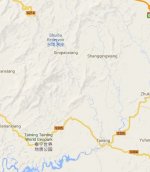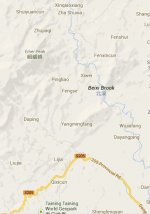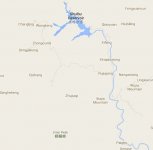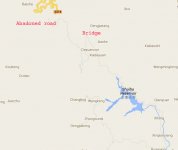mjgrunwell
Well-known member
Japanese waxwing at Wuyuan, Sunday 16 Feb 2014
Following a report of the rare, elusive and enigmatic Japanese waxwing, Dave Woodford, Stephen An and I headed off to Wuyuan on Saturday night.
Dawn broke damp and overcast at the blue-crowned LT island near Wuyuan, see attached maps(EDIT maps removed at request). We checked the trees and saw several orange-bellied leafbird and 2 asian barred owlet but no waxwing. Stephen then found the small flock but they flew before we could reach them. After another half hour I retreated to higher ground to get an overview of the area and scoped a flock in trees at the very northern tip of the banana-shaped island. I phoned Dave to tell him his much sought-after species was less than 100m from him. Smiles and much relief all round.
I was struck by how much smaller they are than Bohemian, unfortunately other than the red at tail tip and the darker reddish brown the poor light meant I could not fully savour the other ID points.
After breakfast the rain started and continued all day. We visited the scaly-sided site (see earlier post on this thread) and quickly found 3 pairs and a redhead on the usual stretch, 16 had been reported previously.
We then spent many hours walking the trail that leads north on the eastern shore, it turns to the east and climbs a wooded valley with much bamboo. This is the site where short-tailed parrotbill is reasonably easy to find, however the persistent rain meant most birds were lurking in the forest and reluctant to show. Dave and I may well have glimpsed our target species but we just could not get the views.
Our last stop was a walk up the valley some distance west which holds Silver and possibly Elliot’s pheasant (still have not worked out where exactly this is), very little seen bar a pair of WC forktail and mountain bulbul.
Best birds seen around Wuyuan, Sunday 16 Feb
Scaly sided merganser 7
Crested goshawk 1 presumed male perched up.
Asian barred owlet (WT) 2
Grey-capped pygmy woodpecker, this and GS are common and easy to see on the island
Eurasian jay 3+ on island
Red-billed blue magpie, 6+
Japanese waxwing (WT) 8+ seen, 20 reported 2 days prior
Mountain bulbul (WT) 2 seen well
Huet’s fulvetta commonest bird in woodland
White-crowned forktail 2
Olive-backed pipit, several flocks along field edges
Chinese grosbeak 1
Yellow-browed bunting fairly common
Orange-bellied leafbird (WT), at least two males in full song on the island with several females, rather incongruous to see such an exotic species in a damp bare woodland.
We would have had a much better day if it had stayed dry.
Following a report of the rare, elusive and enigmatic Japanese waxwing, Dave Woodford, Stephen An and I headed off to Wuyuan on Saturday night.
Dawn broke damp and overcast at the blue-crowned LT island near Wuyuan, see attached maps(EDIT maps removed at request). We checked the trees and saw several orange-bellied leafbird and 2 asian barred owlet but no waxwing. Stephen then found the small flock but they flew before we could reach them. After another half hour I retreated to higher ground to get an overview of the area and scoped a flock in trees at the very northern tip of the banana-shaped island. I phoned Dave to tell him his much sought-after species was less than 100m from him. Smiles and much relief all round.
I was struck by how much smaller they are than Bohemian, unfortunately other than the red at tail tip and the darker reddish brown the poor light meant I could not fully savour the other ID points.
After breakfast the rain started and continued all day. We visited the scaly-sided site (see earlier post on this thread) and quickly found 3 pairs and a redhead on the usual stretch, 16 had been reported previously.
We then spent many hours walking the trail that leads north on the eastern shore, it turns to the east and climbs a wooded valley with much bamboo. This is the site where short-tailed parrotbill is reasonably easy to find, however the persistent rain meant most birds were lurking in the forest and reluctant to show. Dave and I may well have glimpsed our target species but we just could not get the views.
Our last stop was a walk up the valley some distance west which holds Silver and possibly Elliot’s pheasant (still have not worked out where exactly this is), very little seen bar a pair of WC forktail and mountain bulbul.
Best birds seen around Wuyuan, Sunday 16 Feb
Scaly sided merganser 7
Crested goshawk 1 presumed male perched up.
Asian barred owlet (WT) 2
Grey-capped pygmy woodpecker, this and GS are common and easy to see on the island
Eurasian jay 3+ on island
Red-billed blue magpie, 6+
Japanese waxwing (WT) 8+ seen, 20 reported 2 days prior
Mountain bulbul (WT) 2 seen well
Huet’s fulvetta commonest bird in woodland
White-crowned forktail 2
Olive-backed pipit, several flocks along field edges
Chinese grosbeak 1
Yellow-browed bunting fairly common
Orange-bellied leafbird (WT), at least two males in full song on the island with several females, rather incongruous to see such an exotic species in a damp bare woodland.
We would have had a much better day if it had stayed dry.
Last edited:









